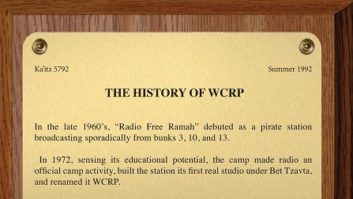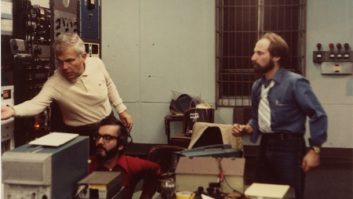
This commentary is substantive but it’s also personal. Low-power FM radio has been my primary passion in life for the last 16 years. In 1997, I joined electronics technician and inventor Nickolaus Leggett in a Petition for Rulemaking to the FCC (RM-9208, later merged into MB Docket 99-25). This made me one of the first two parties to propose LPFM. In 1998, when the FCC began deliberations on LPFM, I co-founded, and led, The Amherst Alliance, an Internet-based citizens’ group that lobbied for LPFM.
In 2011, Congress enacted the Local Community Radio Act, mandating a major expansion of the LPFM radio service. At that time, I promised myself that I would phase out of LPFM activism and move on to other issues once the FCC had completed LCRA implementation.
Now LCRA implementation has been largely completed. So far, however, my personal transition away from activism on low-power radio has been more limited than planned. I have resigned as president of the Amherst Alliance, started to write a book and taken on certain American Indian landowners as paying clients on various federal issues; still, I remain concerned with unfinished business.
Power levels: The LPFM power levels are too narrow. Because the FCC will not license LPFMs below 50 watts, many potential LPFMs are too large to “fit” in the crowded spectrum of urban areas. Meanwhile, because the FCC also declines to license LPFMs above 100 watts, viability is problematic for some potential LPFMs in small towns and rural areas.
An LPFM station remains possible for least 80 percent of America’s population, but what about the rest of us? The U.S. military has a slogan: “Leave no one behind.” The Left of Center equivalent is the slogan: “Solidarity forever.” Personally, I feel a moral obligation to include those Americans who have been left out.
250 watt LPFMs: On Dec. 19, 2013, Nick Leggett and I filed a Petition for Rulemaking. It would allow selected LP100 stations to upgrade to 250 watts. There are two caveats. The LP100 must be located in a “small town or rural area,” defined as a proposed service area that falls completely outside of any Standard Metropolitan Statistical Area, with locations inside Micro Standard Statistical Areas being acceptable. The LP100 must demonstrate it has been on-air for a “shakedown cruise” of at least two years, with a clear record of technical competence and regulatory compliance.
With respect to LP250 siting, a debate may be brewing inside the LPFM movement. Leggett and I, among others, stand by the original Amherst Alliance vision that LP250s should serve small towns and rural areas. Today, however, REC Networks and The Prometheus Radio Project seem to back licensing LP250s anywhere — including even urban areas, where they might blur the local focus and “crowd out” a greater number of smaller LPFMs.
LPFMs below 50 watts: Michelle Eyre Bradley, owner of REC Networks (www.recnet.com), has agreed to “take the lead” on a future petition to the FCC to allow the commission to authorize LPFMs below 50 watts, at least in selected areas.
The agency has clearly concluded — wrongly, in my opinion — that urban 10-watt LPFMs are too small to be viable. Therefore, the question arises: If 49 watts become the upper limit for a new class of LPFM station, what power level (presumably, above 10 watts) will be the lower limit?
My own “fallback” recommendation is 20 watts. This is the wattage at which Radio Mutiny of Philadelphia, the former “pirate” radio station that evolved into The Prometheus Radio Project, proved itself viable, and influential, for several years.
Low-power AM: Last decade, in response to a Petition for Rulemaking by The Amherst Alliance, The LPAM Network and others, the commission opened Docket RM-11287. Public comments were sought, and received, on possible licensing of low-power AM stations. Ultimately, however, the petition was neither granted nor rejected.

Now, however, the FCC is considering Docket 13-249, proposals for revitalization of the AM band. In this proceeding, reopening of Docket RM-11287 has been urged by Nick Leggett, William Walker, president of the LPAM Network (lpam.net) and me.
All of us endorsed an April 28, 2006 proposal in Docket RM-11287, reflecting a consensus of all LPAM advocates at the time, which would pattern AMs after 10-watt Travelers’ Information Stations. Other commenters in Docket 13-249 endorsed LPAM as a general concept, while Jim Potter of Missouri proposed LPAMs of “150 to 300 watts.”
Translator localism: LPFM stations can be licensed directly. The commission, however, can also allow translators to become something akin to LPFMs. This idea first surfaced in a Petition for Rulemaking filed on April 27, 2006, by several small Midwestern broadcasters, led by Randal J. Miller of Miller Media Group in Taylorville, Ill.
In the petition, the group asked the FCC to allow translators the option of airing locally originated programming. The agency invited and received public comments on the petition, docketed as RM-11331. Although the commission neither granted nor denied the petition during the ensuing years, the FCC has kept RM-11331 open for the submission of additional comments.
Not all LPFM advocates endorsed such translator localism, but a solid majority of Amherst Alliance members voted to file strongly supportive comments. Within the LPFM community, the dividing line seemed to be whether the LPFM advocates viewed their highest priority as promotion of LPFMs in particular — or promotion of broadcast localism in general, even if the exact forms are varied.
On April 27, 2011, in its own Petition for Rulemaking, The Amherst Alliance filed a refined version of the original proposal. Public comments on the Amherst alternative were not solicited, but the Media Bureau posted it as Docket number PRM11MB.
Amherst noted that the current version of the Local Community Radio Act does not permit a secondary service station, whether a translator or an LPFM, to rise to primary service status. Neither, however, does the LCRA prohibit the FCC from subdividing the secondary service class into smaller sub-groups, with some sub-groups “outranking” others inside the same class.
To encourage more locally originated programming on all secondary service stations, including both translators and LPFMs, Amherst proposed to allow locally focused stations to have a priority over other secondary service stations in spectrum allocation. A phased-in commitment to minimum levels of locally originated programming would be required.
In summary, all of this unfinished business can probably be resolved within two years, or less, if the commission is motivated and supporters are vocal.
Don Schellhardt is a longtime advocate of LPFM and LPAM. He has been a government relations attorney since 1975. Reach him via email at [email protected].
Comment on this or any story. Email [email protected] with Letter to the Editor in the subject line.










